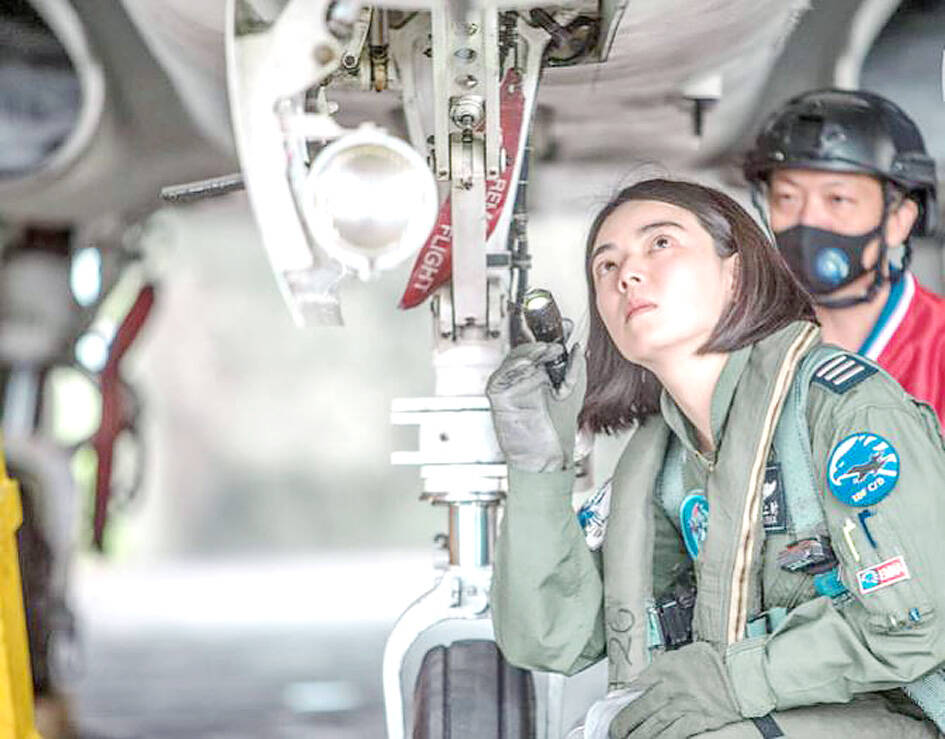An interview with female air force pilots in Taiwan published by the UK’s Telegraph newspaper on Sunday highlights their strong willpower, responsibility and resilience as female fighter pilots, despite facing increasing Chinese military threats.
The report interviewed 34-year-old Captain Guo Wen-jing (郭文靜) and 33-year-old Major Hsieh Yun-ting (謝蕓梃), who are the air force’s fourth and third fighter pilots respectively.
Guo studied business management at university and briefly considered working in a bank after graduation, but at the age of 22, she was drawn to the challenge of enlisting in the military, particularly in aviation, the report said.

Photo courtesy of Military News Agency
The promise of a steady wage cemented her decision, as she had hoped to support her family in covering expensive late-stage cancer treatments for her late father at the time.
“I thought: If the boys can do it, then girls can, too… I didn’t even tell my family what I was up to until the morning I was assigned to report for duty,” the newspaper cited her as saying.
During her childhood, Hsieh often watched planes taking off and landing at a nearby airport and military air base in Kaohsiung, and she now trains future fighter pilots on AT-3 trainer aircraft.
“I wondered if perhaps someday I could fly one of those planes,” the report cited her as saying.
On her first solo flight, she said she looked behind in the plane, not convinced that she was flying alone without an instructor, but she told herself “you got this” and succeeded, because she believed in herself, the report cited her as saying.
Days usually begin at about 5am for Guo and Hsieh, but sometimes they can start as early as 3am.
Other than their military duties, they need to manage their responsibilities at home — Hsieh is a mother of two children, aged seven and five.
As women comprise only about 15 percent of active-duty personnel in the military, and most female pilots end up flying transportation planes, there are only 20 female fighter pilots, the report said.
There were so few women when they started their pilot training about a decade ago, that “our officers placed us under a magnifying glass — at least, that’s what it felt like,” Guo was cited as saying.
Recruiting has not been easy in Taiwan, as the military’s public image has long been associated with repression, due to the history of martial law until 1987, so Guo’s two older brother still tease her for becoming a soldier and are not interested in enlisting themselves, it said.
However, Guo and Hsieh’s sense of accomplishment from having joined the elite ranks of the air force cannot be replaced, it reported.
Beijing commands six times as many warplanes as Taiwan and has increasingly sophisticated aircraft, so as tensions rise over a potential invasion of Taiwan, Guo and Hsieh might one day be at the forefront of a war with China, the report said.
Facing Beijing’s military advantages, the female fighter pilots have shown how to stay calm during their missions to intercept Chinese aircraft, as well as demonstrating determination to defend Taiwan, it added.

Taiwan is to commence mass production of the Tien Kung (天弓, “Sky Bow”) III, IV and V missiles by the second quarter of this year if the legislature approves the government’s NT$1.25 trillion (US$39.78 billion) special defense budget, an official said yesterday. Commenting on condition of anonymity, a defense official with knowledge of the matter said that the advanced systems are expected to provide crucial capabilities against ballistic and cruise missiles for the proposed “T-Dome,” an advanced, multi-layered air defense network. The Tien Kung III is an air defense missile with a maximum interception altitude of 35km. The Tien Kung IV and V

The disruption of 941 flights in and out of Taiwan due to China’s large-scale military exercises was no accident, but rather the result of a “quasi-blockade” used to simulate creating the air and sea routes needed for an amphibious landing, a military expert said. The disruptions occurred on Tuesday and lasted about 10 hours as China conducted live-fire drills in the Taiwan Strait. The Civil Aviation Administration (CAA) said the exercises affected 857 international flights and 84 domestic flights, affecting more than 100,000 travelers. Su Tzu-yun (蘇紫雲), a research fellow at the government-sponsored Institute for National Defense and Security Research, said the air

Taiwan lacks effective and cost-efficient armaments to intercept rockets, making the planned “T-Dome” interception system necessary, two experts said on Tuesday. The concerns were raised after China’s military fired two waves of rockets during live-fire drills around Taiwan on Tuesday, part of two-day exercises code-named “Justice Mission 2025.” The first wave involved 17 rockets launched at 9am from Pingtan in China’s Fujian Province, according to Lieutenant General Hsieh Jih-sheng (謝日升) of the Office of the Deputy Chief of the General Staff for Intelligence at the Ministry of National Defense. Those rockets landed 70 nautical miles (129.6km) northeast of Keelung without flying over Taiwan,

City buses in Taipei and New Taipei City, as well as the Taipei MRT, would on Saturday begin accepting QR code payments from five electronic payment providers, the Taipei Department of Transportation said yesterday. The new option would allow passengers to use the “transportation QR code” feature from EasyWallet, iPass Money, iCash Pay, Jkopay or PXPay Plus. Passengers should open their preferred electronic payment app, select the “transportation code” — not the regular payment code — unlock it, and scan the code at ticket readers or gates, General Planning Division Director-General Liu Kuo-chu (劉國著) said. People should move through the